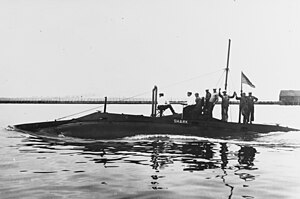USS Shark (SS-8)
 USS Shark (SS-8)
| |
| History | |
|---|---|
| Name | USS Shark |
| Builder | |
| Laid down | 11 January 1901 |
| Launched | 19 October 1901 |
| Commissioned | 19 September 1903 |
| Decommissioned | 12 December 1919 |
| Stricken | 16 January 1922 |
| Fate | Sunk as a target |
| General characteristics | |
| Class and type | Plunger-class submarine |
| Displacement | 107 long tons (109 t) |
| Length | 64 ft (20 m) |
| Beam | 12 ft (3.7 m) |
| Draft | 11 ft (3.4 m) |
| Speed |
|
| Complement | 7 |
| Armament | 1 × 18 inch (450 mm) torpedo tube |

USS Shark (SS-8) was the third vessel of the U.S. Navy to bear the name. She was an early Plunger-class submarine in the service of the United States Navy, later renamed as A-7.
Shark was laid down on 11 January 1901 at
Early service
Over the next three and a half years, Shark operated locally at the
Taken to the
Over the next several years, the submarine torpedo boat operated out of Cavite, interspersing training with periodic upkeep and repair work. On 17 November 1911, Shark was renamed A-7.
World War I
During
After Marcus and his men had battled the blaze, he ordered the crew topside and into the boats that had been summoned alongside. The last man to emerge from the interior of the crippled submersible, Marcus sent up distress signals to the nearby monitor Monadnock and then took the helm himself in an attempt to beach the ship. He refused medical treatment until all his men had been attended to and he had to be ordered to leave his post. Marcus and six of his crew died the next day, 25 July 1917, from the effects of the explosion and fire that had ravaged A-7. The last remaining member of the crew, Fireman Second Class Arthur M. Jacobs, succumbed to his injuries on 1 August 1917. The Navy recognized Marcus' heroism by naming the destroyer Marcus in his honor.
Later service
Placed
References
- Wright, C. C. (2003). "Question 40/02: Submarines Expended as Targets 1922". Warship International. XL (4): 286–298. ISSN 0043-0374.
![]() This article incorporates text from the public domain Dictionary of American Naval Fighting Ships. The entry can be found here.
This article incorporates text from the public domain Dictionary of American Naval Fighting Ships. The entry can be found here.
